A lot of ink, both real and virtual, has been spilled over the Glock 43 pistol. It’s understandable why. For roughly 20 years, there has been a clamor among the Glock faithful for a single-stack 9mm pistol. All of that pent up demand has now been unleashed, and everything related to the new gun stands to bring customers through the doors.
Rather than being the first to publish a review of the new Glocks, I decided to aim for a much more in-depth examination of the firearms. I’ve had this test gun since May, and have shot and carried it extensively since then. I’ve also had others shoot it in a training class, and I solicited their opinions on the carry gun.
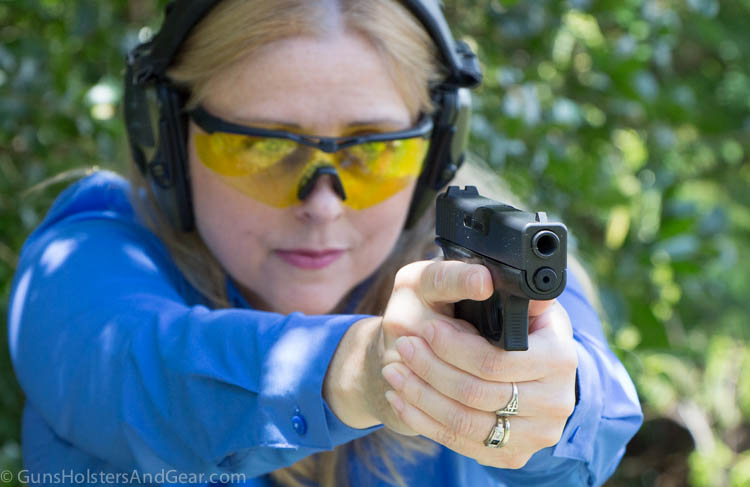
I’ve got a pretty solid feel for this pistol, and I hope I can relate that to you. Although I think it would behoove you to read the complete review, I’ll save the time crunched reader with my bottom line: the gun is very good, though not for everyone. I’m buying one for my personal use, and I expect it will be my daily carry for any time I am not testing another pistol.
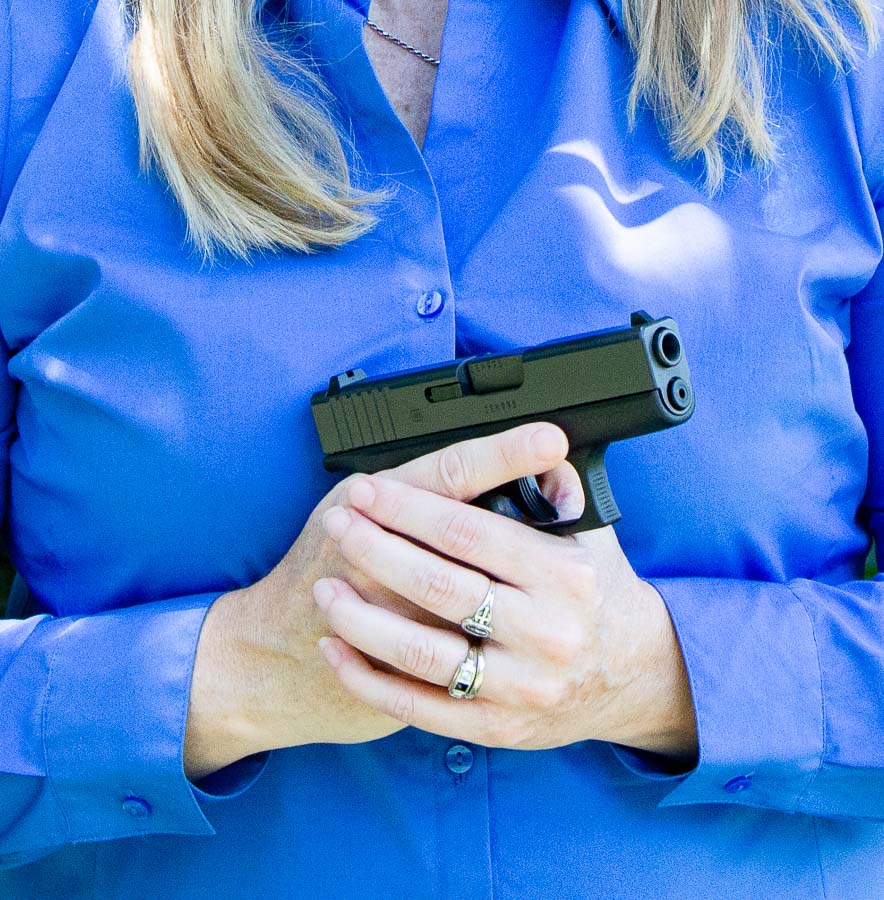
Where to Buy Glock 43
The G43 is a solid, striker fired pistol that will serve the self-defense needs of many people. I recommend it. I also suggest purchasing the gun through one of the below affiliate links.
- Palmetto State Armory (best price)
- Guns.com
- Sportsman’s Warehouse
- Sportman’s Guide (offers interest free payments)
I’ve done business with all of these companies and found them to be good people to work with. I willingly spend my own money with them.
General Information
As you may already know, the Glock 43 is a compact 9mm pistol, similar in size to the Smith & Wesson Shield, Walther PPS and Kahr CM9. In general, it appears to be a tool ideally suited for concealed carry and as a backup gun for uniformed law enforcement officers.
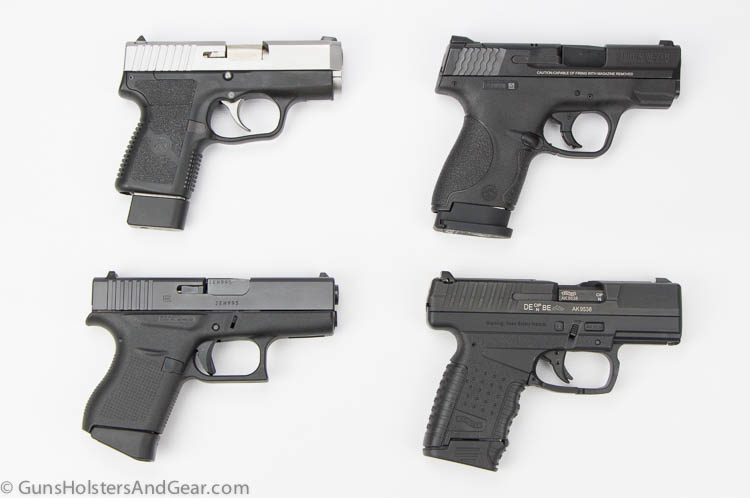
With all of the expectations associated with this gun, there is a lot of pressure on Glock to deliver. As a man who’s relied on Glock pistols for literal life-saving application, I especially expected the company to produce a handgun that would reliably run.
The good news is the gun delivered the performance I expected. Surprisingly, the gun had to grow on me a little before I truly accepted it.
Not Love at First Sight
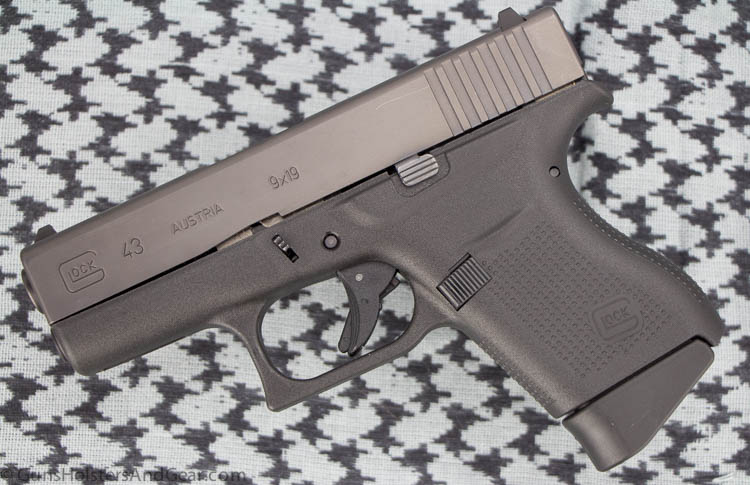
Much to my personal disappointment, I did not like the G43 at first. I’m a long-time Glock shooter, but my first experience with the gun was not especially grand.
I had been invited in April to the launch party Glock threw right before the NRA show. Good friend Paul Carlson and I attended, and we had a chance to shoot the gun then. Weirdly, I did not have an instant like of the gun. In fact, I was a little let down.
The pistol ran fine, and there were certainly plenty of people on hand who did like the gun. But I didn’t have that instant liking that I did with the G19.
I’d traveled all day to get to the event, so I figured that my impressions of the gun may have been unfairly colored by a general malaise often associated with long trips. Instead of writing about my lackluster impressions of the gun, I instead wrote about why Glock designed the G43 and included the experiences of a brand new shooter.
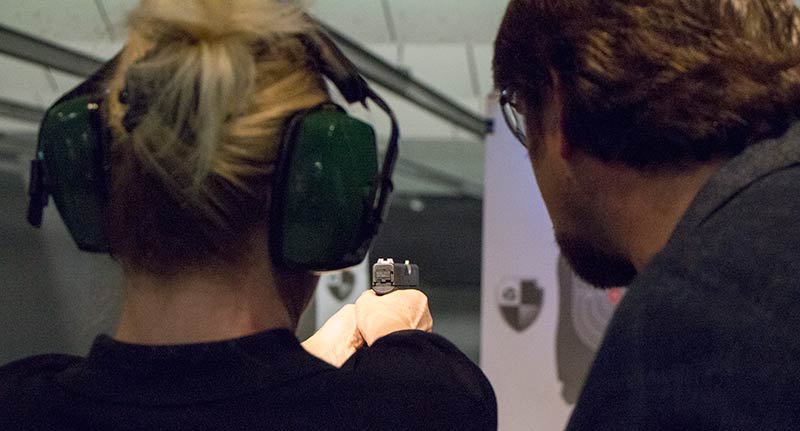
However, I wanted to get the G43 back on the range and find out if I really liked it or not. I had a magazine assignment come up that would put guns in the hands of new shooters, and Glock was happy to provide some pistols for the event. One of those pistols was the Glock 43 detailed in this review.
I’m very glad I gave the G43 another test drive. Before I get too far down the road of my experiences, let me describe this great gun to you.
G43 Specifications
| Model | G43 |
| Caliber | 9mm |
| Magazine Capacity | 6 rounds |
| Barrel Length | 3.41″ |
| Overall Length | 6.26″ |
| Overall Width | 1.06″ |
| Weight (with empty magazine) | 17.99 oz |
| Action | striker-fired, DAO |
| Sights | polymer, dot front, box/notch rear |
| Color(s) | black |
| MSRP at Launch | $589 |
Some have described the G43 as a single stack version of the Glock 26. This is a fairly accurate description. The newer gun is a lot thinner than the G26, though its length and height are similar.
With the included finger extension base plate on the magazine, the firearm fits my medium-sized hands with no room to spare. For someone with larger hands, you may have some of your pinky falling off the bottom of the gun.
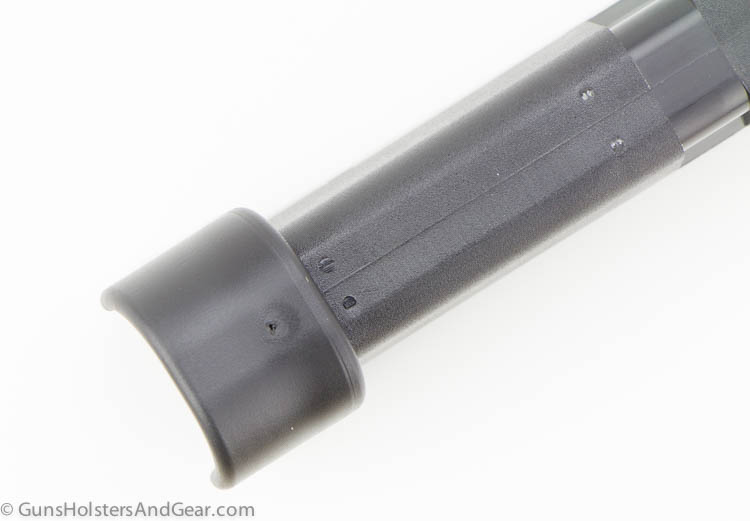
On my G43, there was a small bump on the forward face of the pinky extensions. This raised dot was likely the result of the plastic molding process as it does not resemble the other areas of the grip. While it isn’t the prettiest thing I’ve ever seen, the bump is no larger or sharper than any of the other intentional bumps in the grip texture.
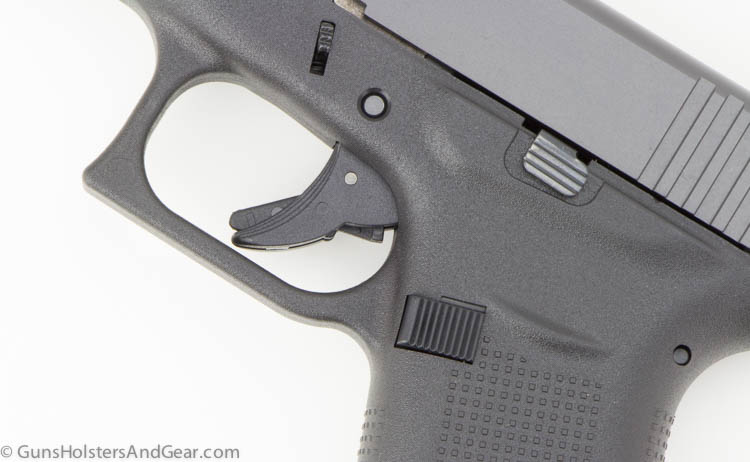
Glock gave the pistol the general Gen4 treatment. It does not have the modular backstrap system than the larger guns have. However, it does have the improved texture, larger magazine release and double recoil spring assembly common to the Gen4 guns.
Sights are typical “dot and box” type sights that are used across the line. They are not, however, exactly identical to full-size Glock handgun sights.
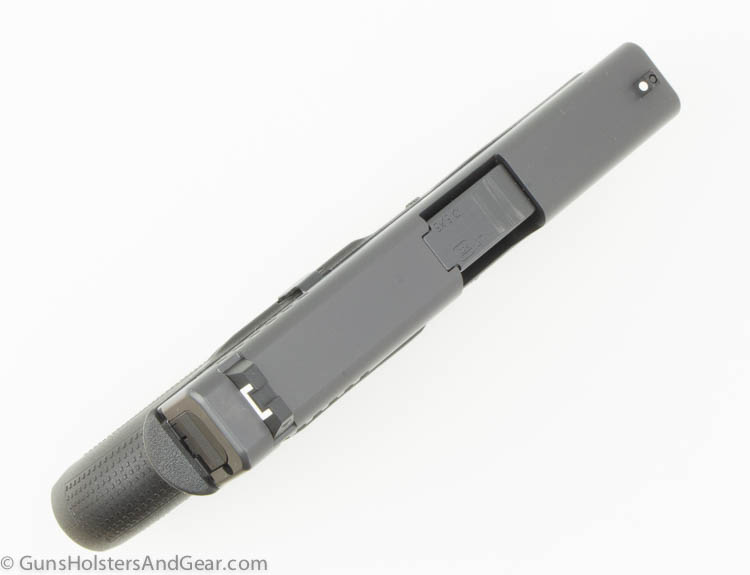
I spoke with a Glock engineer about the gun’s sights. He advised that the front sight is the same size as the front sight on the full size pistols. The rear sight, however, is narrower than full size sights to fit the thinner slide.
If you want to upgrade the sighting system on your G43, check out my round-up of Glock 43 sights here.
Take down is the same as any other Glock.
Accessories for the Glock 43
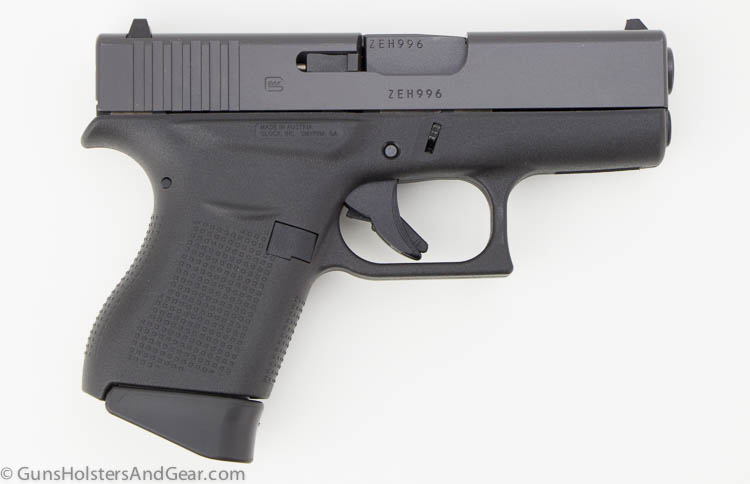
Let’s face it – the Glock 43 is not a sporting gun; it is made to be carried for self-defense. This size and design of the gun will appeal to many people looking for a concealed carry firearm.
I’ve carried a concealed handgun for more than 20 years. Over the years, my wants and needs have changed. Yours are likely to vary in some degree from mine. So, while I say the G43 worked exceptionally well for me, you may not like it quite as much.
In my opinion, this pistol worked very good as an IWB handgun. I’ve carried a lot of guns, but none so frequently as my second gen Glock 19. While I do sacrifice magazine capacity, I gain a lot in concealability and comfort by transitioning to the G43.
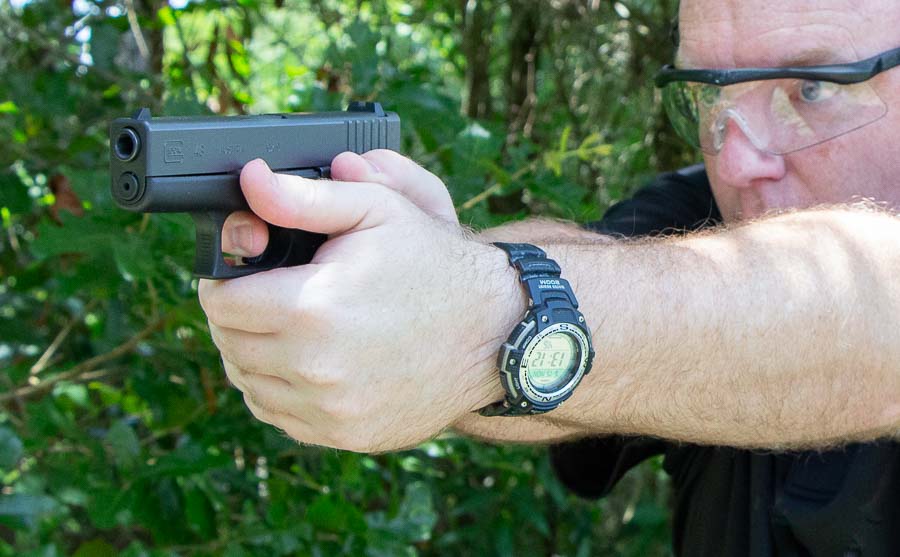
There has been a lot of ballyhoo on the internet about the relatively limited magazine capacity of the G43. Personally, I believe that is a lot of worry over nothing for most people.
I would be a liar to suggest that I’m happy about leaving a 15-round magazine behind for a 6-rounder. But, I’ve occasionally relied solely on a 5-shot J frame for concealed carry and backup duties. Heck, I’ve even carried a 6-shot wheel gun as a duty gun in uniform.
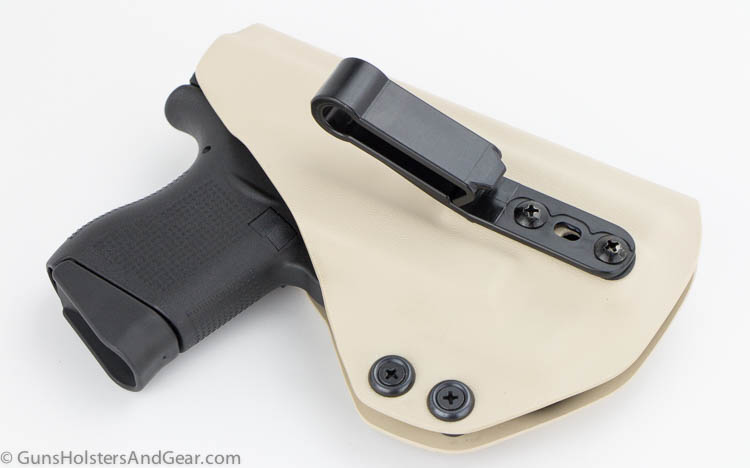
Unlike years past when I was still employed in law enforcement, I have no current credible threats on my life. If I did, the G19 would merely be one of the guns I carried. Since I do not, I am willing to reduce capacity for increased convenience. As my circumstances change, so will my gun selection.
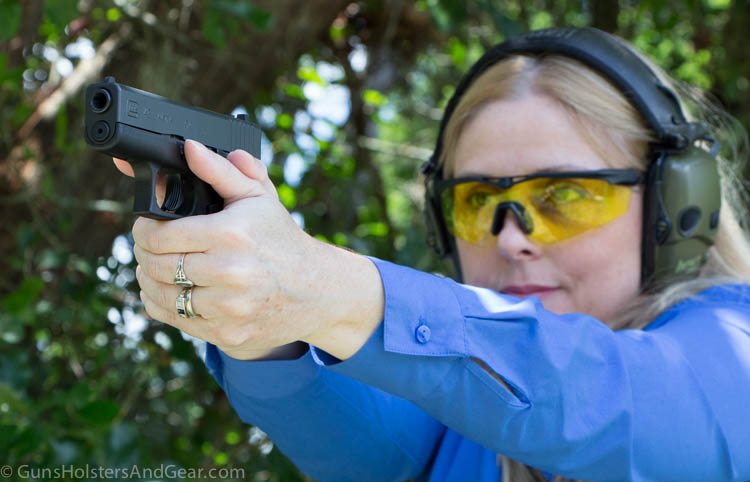
For me, the gun did not work well for pocket carry. It seemed to make all the wrong bulges in cargo pant pockets. I tried a range of pocket holsters and simply could not find one that worked for me. You may have better luck. Since the pistol works so well for IWB carry, I wasn’t worried about the lack of pocket carry.
Ankle carry is perfectly fine with this pistol. I didn’t have a fancy rig, but I tried it out with an old Uncle Mike’s holster I have. It’s not my preferred carry location for a primary weapon, but for a uniformed cop it can be a real-life saver.
The gun ships with two mags. I always recommend that you pick up a few extra, regardless of which Glock generation you have. If this is you carry a Glock regularly, I recommend more than just a few. That way you have some to practice with and you have a reliable reload for your favorite carry.
Holster Options
With all of the anticipation for this pistol, it was clear to a lot of holster makers that they should hit the ground running with carry rigs for the G43. That has worked out great for consumers, as just a few months after the new Glock was announced, shooters had a wide range of carry options available.
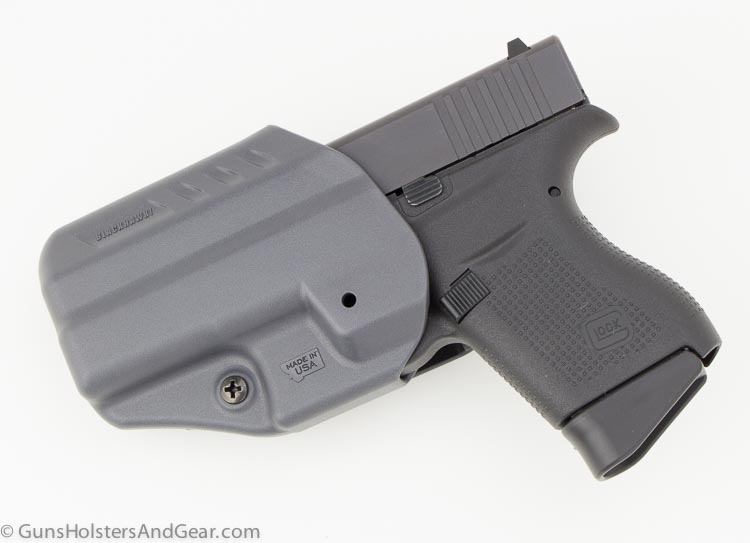
When testing the G43, I had a number of holsters on hand that I tried out. These included the Blackhawk A.R.C., the YetiTac FireSide and QuickClaw holsters and several options from Vedder Holsters. I ran IWB, OWB and appendix rigs.
While any of these holster options will work well, you may want to check out my round up of G43 holsters here. I’ve put together a list of different carry rigs that are currently on the market for the pistol.
Lights and Lasers
As with the holster makers, accessory manufacturers have jumped into the G43 market with both feet. At the time of this writing, there are already multiple light and laser attachments on the scene.
Some of these options include:
- Streamlight TLR-6 (light and red laser)
- Crimson Trace 443 Laser (red laser)
- Crimson Trace 443 Laser (green laser)
- LaserLyte TGL UTA-YY (red laser)
- Viridian Reactor 5 (available with either red or green lasers)
- Viridian Reactor TL (light)
For this review, I was able to get a TLR-6, and I already had a TGL on hand. Here’s what I found on how well they worked.
Streamlight TLR-6
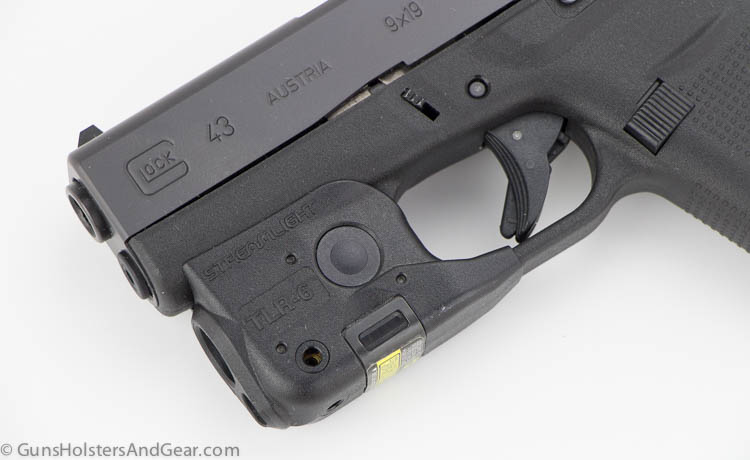
The TLR-6 is a combination white light and red laser similar to the company’s existing TLR-2 and TLR-4 lines. However, instead of mounting to an accessory rail, this unit attaches to the trigger guard.
Installation is quick and simple: two halves clamp over the trigger guard and three screws hold them in place. Windage and drift adjustments are handled by recessed screws. A hex wrench is included for mounting the light and making aiming adjustments.
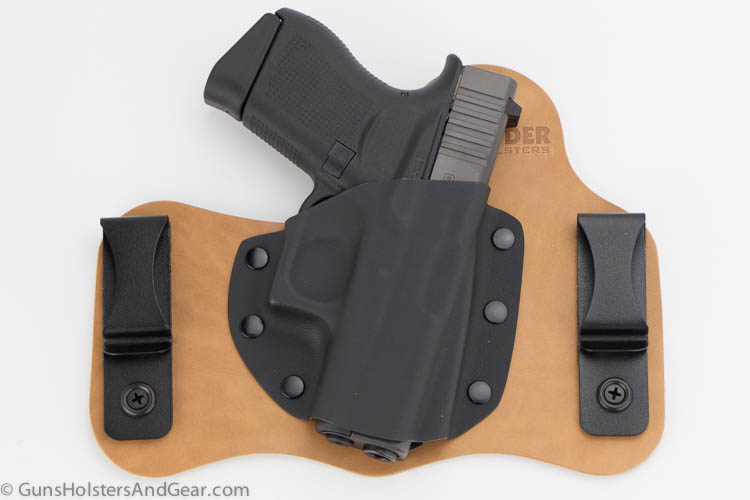
The red laser is quite bright – though like all red lasers, it is not going to show up well in full daylight. The white light is bright enough to positively identify threats, but is not overwhelming like some of the current full-size weapon lights on the market today.
Overall, I thought the unit did very well when mounted to the Glock. I’ve got a full review of the TLR-6 here.
LaserLyte TGL
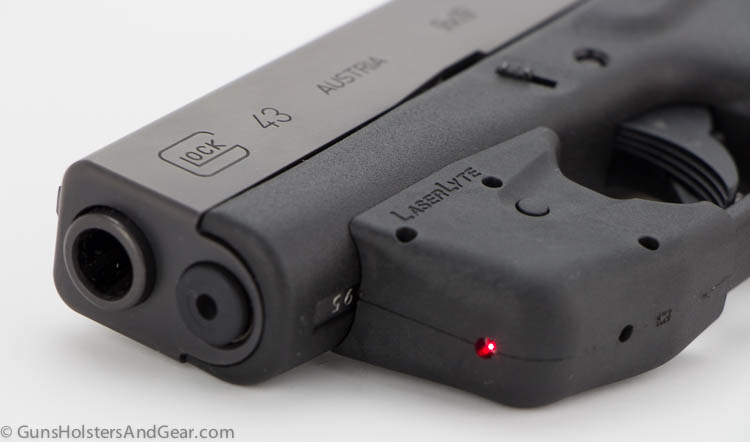
Last year, I reviewed the LaserLyte TGL for the Glock 42. The company stated that the TGL will also fit the newer G43, and I confirmed it during this testing.
The TGL mounted easily to my G43. Compared to the Streamlight, the TGL was a tighter fit to the gun. However, the buttons are smaller on the TGL, and were a little harder for me to manipulate. During shooting, it held zero and caused me no concern. You can check out my full review of the LaserLyte laser here.
I would note that there are a split of opinions on Amazon about this unit. It seems half the buyers love it, while half had problems. I don’t know if this is suggestive of a quality control problem, but I had no problems with my unit.
Shooting the Glock: Range Time
With most guns, the best part of reviewing them is getting them on the range. If the gun runs well, it is a fun day shooting. If the gun does not run well, I collect a lot of important data to bring you, the reader. Even though I collected a lot of information, shooting the Glock was definitely in the “fun” not “work” category.
As I stated earlier in this review, my first taste of the handgun was tepid. I’m still not entirely sure why that was because as soon as I got it on the range the second time ’round, I warmed up to it immediately.
This Glock 43 was one of several handguns I had on hand for a small group of new shooters that were going through a training course. During the class, the gun was shot by a petite homeschooling mom and an athletic male firefighter. With several hundred rounds, neither shooter experienced a single malfunction with the gun.
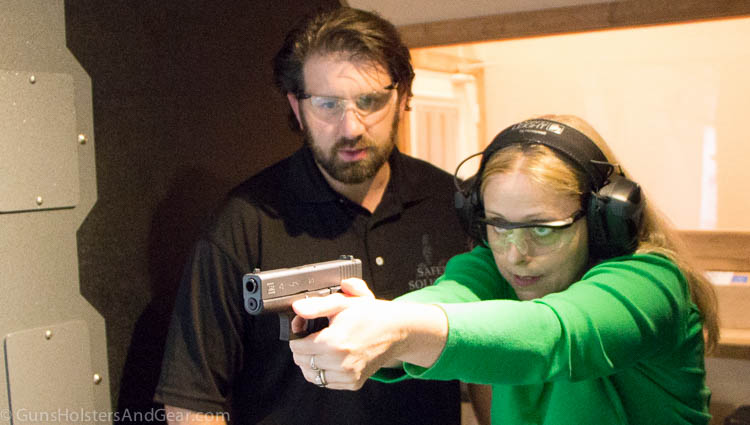
Both of the students I spoke to enjoyed shooting the pistol. The mother ultimately preferred shooting the Glock 19, but had no problems handling the smaller gun. On the other hand, the firefighter chose to run the G43 even when other guns were available.
The woman in the class said she had to exert a greater degree of force on the gun to properly control it than on the Smith & Wesson Shield and Walther PPS pistols she also shot. However, she said that it was only a problem from the standpoint of fatigue setting in sooner, not from an inability to control the recoil.
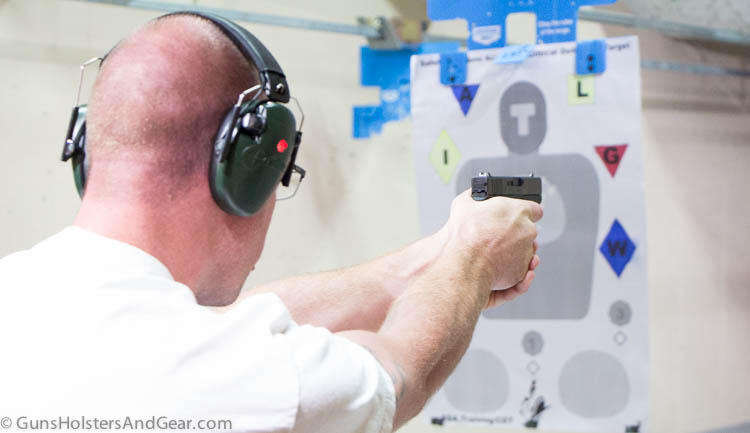
A few days after the training class, I went back to the range for some private time with the compact 9mm. After a few hours, I was hooked on the gun. It ran flawlessly and seemed as accurate as any other pistol I own (subject to my own ability to run it of course.)
Shooting small guns can sometimes be an exercise in masochism. Although thinner than other Glock models, the G43 did not abuse the hand as some thin pistols can. I felt that recoil was a little snappy, but not uncontrollable. With the finger extension on the magazine, I had plenty of hand on the gun to keep muzzle flip to a minimum and control the recoil.
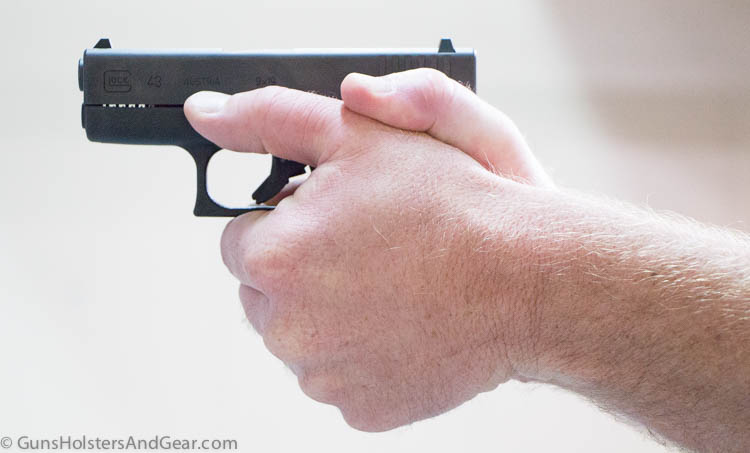
The trigger pull felt slightly heavier than that on other Glock pistols I have shot. My digital Lyman trigger pull gauge showed an 10-pull average of 5 pounds, 13.5 ounces – barely higher than the stated factory spec of 5 pounds, 8 ounces. I suspect the reason is feels slightly heavy has to do with my finger placement on the trigger being different than that on the full-size handguns.
The pull motion was all Glock with a crisp break and obvious reset. If you like the Glock trigger, you will be at home with the pull on the G43.
Ammunition Performance
For this article, I ran 12 different factory loads through the G43. Ammo included ball and hollow point loads, plus the entire gamut of pressures and velocities. Across all of these, the Glock performed with 100% reliability. (Ed. note: Since this review was written, I have shot more loads through this pistol and have added the velocity information in the table below. There have not yet been any malfunctions with this pistol.)
| Velocity | Energy | |
| Blazer Brass 115 gr FMJ | 1,066 fps | 290 ft-lbs |
| Federal BPLE 115 gr +P+ | 1,178 fps | 354 ft-lbs |
| Federal Champion 115 gr FMJ | 1,069 fps | 292 ft-lbs |
| Federal HST 124 gr +P | 1,120 fps | 345 ft-lbs |
| Hornady American Gunner 124 gr XTP +P | 1,036 fps | 296 ft-lbs |
| Hornady Critical Defense 115 gr FTX | 1,074 fps | 295 ft-lbs |
| Hornady Critical Duty 135 gr FlexLock | 960 fps | 276 ft-lbs |
| Hornady Critical Duty 135 gr FlexLock +P | 1,049 fps | 330 ft-lbs |
| HPR Ammunition 115 gr JHP | 1,041 fps | 277 ft-lbs |
| HPR Ammunition 124 gr JHP | 929 fps | 238 ft-lbs |
| Liberty Ammunition Civil Defense 50 gr JHP +P | 2,028 fps | 457 ft-lbs |
| Perfecta 115 gr FMJ | 1,053 fps | 283 ft-lbs |
| Remington UMC 115 gr JHP | 1,072 fps | 292 ft-lbs |
| Remington UMC Target 115 gr FMJ | 1,070 fps | 292 ft-lbs |
| SIG SAUER Elite Performance 115 gr FMJ | 1,050 fps | 282 ft-lbs |
| SIG SAUER Elite Performance V-Crown 124 gr JHP | 982 fps | 266 ft-lbs |
| SIG SAUER Elite Performance V-Crown 147 gr JHP | 865 fps | 244 ft-lbs |
| Winchester 115 gr JHP (white box) | 1,058 fps | 286 ft-lbs |
| Winchester PDX1 Defender 124 gr JHP +P | 1,113 fps | 341 ft-lbs |
With short-barreled pistols, there is an expected drop in velocity as compared to larger handguns. While this is true for the G43, in some cases the drop was less than I would have expected. For some loads, the G43 registered velocities closer to duty-sized guns than some its compact contemporaries.
It is unlikely that a few feet per second will make any difference in a self-defense shooting. However, an extra 30-40 fps might help a 9mm hollow point bullet expand in flesh after encountering clothing. I’d not base a handgun purchase decision around this, but I consider it a nice bonus.
Final Thoughts on My Glock 43 Review
The short story is I really like this gun, and I wound up buying one for my own concealed carry needs.
I’ve tried a lot of different guns for concealed carry over the years, and I’ve been pleased with quite a few of them. My Glock 19 and Smith & Wesson 642 are my reliable standbys, though I’ve also carried pistols from Kahr, Bersa, Springfield Armory and SIG Sauer in addition to other models of Glock and S&W. The Glock 43, however, is one that really speaks to me.
This Glock proved itself to be utterly reliable and accurate in my hands. I have little doubt that if the time came, I could adequately defend myself with it.
The gun is not perfect; I’m still hoping that Glock will introduce a single-stack version of the Glock 19. Until that happens, I’ll happily “get by” with the Glock 43.
8 Years Later: Long Term Concealed Carry Results
It’s now 2023, and more than 8 years since Glock introduced the G43 pistol. How has it held up?
Relatively well.
The firearm I purchased continues to run with nary a hiccup. It’s solid and reliable. From everyone I’ve spoken to that owns one, the guns are just as dependable as the larger guns in the company’s catalog.
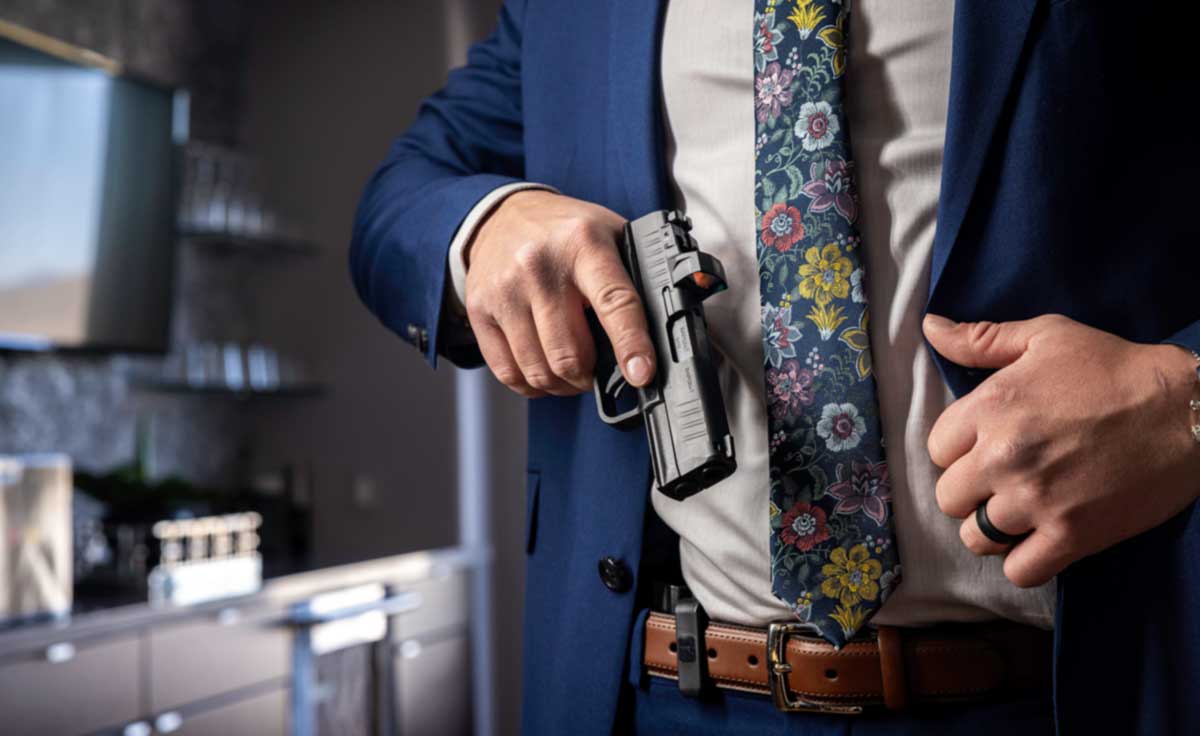
However, not long after Glock introduced this gun, SIG SAUER and Springfield Armory launched new pistols that are roughly of the same size but with more capacity and features.
I carried the G43 for a number of years, but I’ve since swapped over to the Springfield Armory Hellcat Pro as my daily driver. I know a few guys that even prefer the SIG P365 over the Glocks.
I was toting the Hellcat OSP – a gun that nearly doubled the capacity of the G43 plus added a red dot sight – right up until the Hellcat Pro launched in Spring of 2022. Since then, the Pro is my preferred gun.

Is the G43 still a good choice for CCW and as a backup gun? Absolutely. I’d carry one without complaint. There are a lot of “pros” for it, while the obvious con is the capacity. I think it is much better than any of the Taurus offerings including the Taurus G3c that I reviewed here.
But, since I have a choice in what to carry, the Hellcat Pro is my first choice with the original Hellcat remaining on standby for instances where smaller is needed.
Last Update: February 5, 2024
Disclosures
As with all of my reviews, I want you to understand where there might be any biases or conflicts of interest. This gun was loaned, not given, to me by Glock as part of another article I did for Harris Publications. After that article was done, Glock granted me an extension to hold onto the gun for an additional 60 days for this review. I later purchased the standard Glock 43 (no night sights or anything.)
At the time of this review, Glock is not an advertiser or sponsor, nor am I in any talks with them to be one. None of the other companies in this article are advertisers either. I do not have any financial interest in Glock or any of the other companies listed in this article.
GunsHolstersAndGear.com is a for-profit website. I do not charge readers a dime to access the information I provide.
Some of the links on this page and site are affiliate links to companies like Amazon and Palmetto State Armory. These links take you to the products mentioned in the article. Should you decide to purchase something from one of those companies, I make a small commission.
The links do not change your purchase price. I do not get to see what any individual purchases.
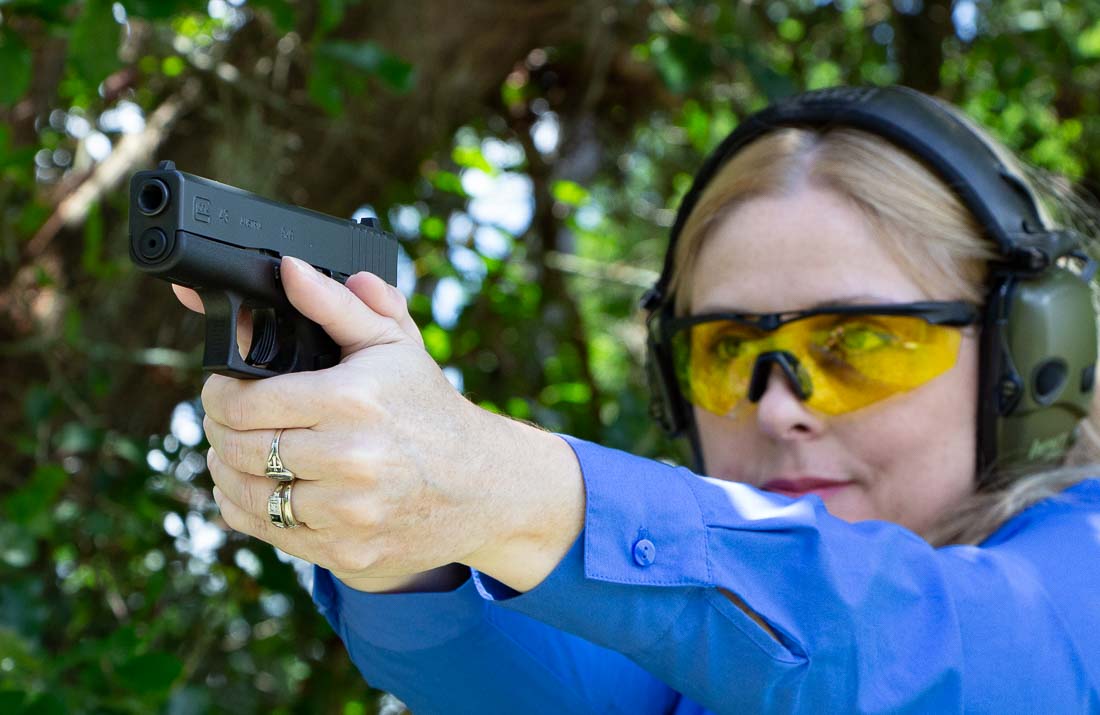
11 replies on “Glock 43 Review”
I see your photos all show the shooters using a thumbs-forward style grip. I was also at the Glock event in April, and seemed to have a less than amazing initial impression as well, and I think some of this was due to the slide not locking open after the last round. I shifted my grip to a more “revolver” curled thumb grip, and it solved it. Did you or your shooters have any complaints or failures to lock on empty with the thumbs-forward grip? I am currently considering a switch from a Shield 9mm to the Glock 43, but was curious if you have any input on that issue. I don’t seem to have the same problem with the Shield.
Thanks.
I did not have that issue with the Glock 43, and no one else who shot the gun seemed to either. But, I’ve experienced what you’ve described when shooting some other guns. I guess it is just a matter of finding what fits your hand best.
For what its worth, my wife shot several guns side-by-side including the G43 and Shield. She would up picking the Shield for her daily driver. Although I like the Shield, I’m currently carrying the G43. I don’t think there is a wrong choice.
Great, thanks for the response. I think I will likely still switch to the 43, but try to adapt my grip a bit. I do like the slight size advantage of the 43, plus the familiarity between Glocks.
Interesting velocity measurements. I got about the same with Remington HTP 115 grain +P as you did with Federal 9BPLE. 1174 vs. 1178 That was unexpected. I’ve been dragging my feet on my review, but I did capture velocity with some loads that you didn’t cover in your list.
I look forward to seeing your review and velocity measurements. That’s interesting about the HTP. But, since there is no SAAMI spec on +P+, I have no idea of how much extra pressure that additional “+” represents from Federal. It may only be an addition 100 psi or something. Enough to garner attention, but not enough to blow up anyone’s gun. I think ammo performance is still about half-voodoo, half-science. 🙂
If I had a dollar for every G43 review I’ve read, I’d be a rich man….OK, that’s an exaggeration. This is the best one I’ve seen. Perhaps it’s because so many of the things said reflect my experience. My wife bought a G42 about 7 months ago and loves it. My EDC is a Sig 290rs, and I’m amazed the G43 is never compared to it. It’s shorter, a little stouter and performs reliability…. But I like the Glock trigger. My bedside gun is a G19….There are several after market products to increase the magazine capacity of the G43. Maybe not enough to deal with a methed up zombie or a Mall shooter with an AK-47 but I don’t go out much after dark….or do much shopping. Nice review Rich!
Thanks for the feedback and compliments. I really appreciate it.
I reviewed the P290RS a couple of years ago and completely failed to mention any comparison between the two here. For me, the trigger on the P290RS make the G43 more appealing to me. A DAK-type trigger makes the P290 much more interesting to me. I certainly don’t think the SIG is a bad choice, just not the best for me. I’m glad you mentioned it!
It’s an older review and not as good as my more recent reviews, but it is here if you would like to read it: https://www.gunsholstersandgear.com/gun-reviews/sig-p290-rs-enhanced-review/
Thanks again for taking the time to post some feedback!
I had read your Sig review a while back…it was one of the reasons I got the 290rs. I saw references to the DAK trigger. Several comments from 290 owners said it wasn’t necessary. I found the stock trigger uncomfortable to shoot and replaced it with an RTK. It has a better shape and is wider than the stock trigger. Makes the gun much more pleasant to shoot.
Thanks for the info on the RTK. I’ve not used one, so I’m happy to get feedback on them to pass along to others.
“I’m still hoping that Glock will introduce a single-stack version of the Glock 19”.
I’m confused. For all intents and purposes, the gun you just reviewed is that gun. A half-inch longer slide and a 2-shot longer grip is just not going to happen.
It may or may not happen, but I believe it would be the ideal fit for me.